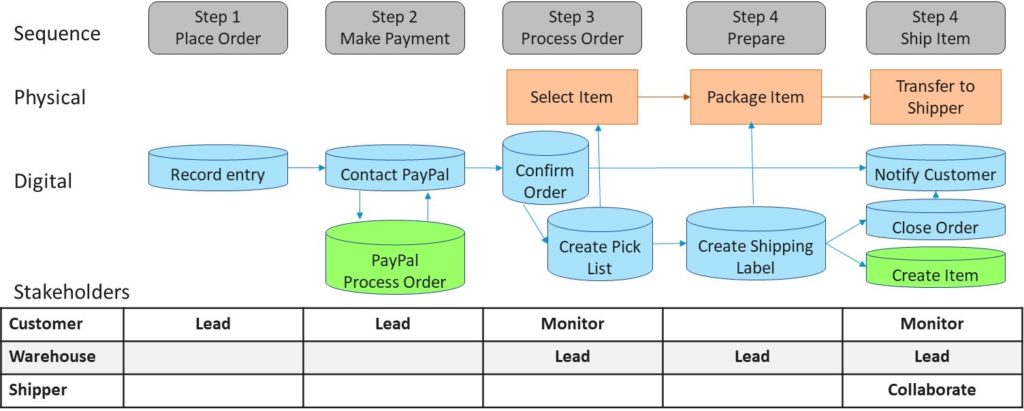Digital Transformation and Industry 4.0 are changing the way we think about many aspects of our business. This includes the processes that make up the business and how those processes are managed. Dr. Edward Deming, in his book Out of the Crisis, described a business as a system of processes. One of Deming’s classic points for business management was, “Improve constantly and forever every process for planning, production and service.” This imperative of constant improvement relies on a thorough understanding of each of the business processes.
Forty years ago, when Deming was writing his books, digital transformation was still science fiction. His focus of analysis was on the physical equipment and people who performed the work of the business processes; first in the manufacturing environment and later in all the business functions. A companion to Deming’s work was the introduction of the concept of LEAN manufacturing which was embodied in the Toyota Total Production System. Again, the emphasis was on the flow of physical parts and assemblies through the business processes. To the extent that there was anything digital involved, it was operational technology, not information technology. By that I mean, the digital technology was used locally at the machine level for machine operations and not networked, communicated, or aggregated into business level information.
Now that we are well into the 21st century, we can recognize that almost all current business processes include a significant amount of digital technology. It may be the IoT sensors that are creating data streams. The digital technology may be the enterprise level software that is tracking transactions and transitions with barcode or RFID data. The digital technology may be the connectivity between computer systems in the cloud or across networks. The digital technology may be the customer persona and account history data that accompanies a transaction. Regardless of the type of digital technology, it is almost guaranteed to be a major part of your business processes.
And this leads us to the need to rethink process management and process improvement. Classic process management consists of defining the flow of an item or transaction through different business steps and then improving and managing that flow. Contrast that with digital management. In most organizations, digital management consists of defining which systems will communicate with each other, specifying the data streams to be communicated, and then monitoring system uptime. But neither perspective is adequate for us to “improve constantly and forever every process.” We need to look at both the physical world and the digital world simultaneously; we need to manage our process as a phygital process.
We should think of a phygital process along four dimensions. Those are sequence, physical elements, digital elements, and stakeholders.
- The dimension of sequence is common to all processes. A process is often defined as a sequence of activities organized to achieve a goal or result. The sequence and timing of the activities of the process are the organizing element. The sequence specifies the start and finish boundaries of the process.
- The physical element is the physical item being processed, physical equipment, and the facility that are needed to complete the activities of the process. As a rule of thumb, this will be managed in the business as capital equipment and inventory. These physical items represent a portion of the value within the company and the efficient use of these are critical to achieving profitability.
- The digital element is the sensors, networks, systems, and applications that create data streams, store data, and convert it into information. This element includes an understanding of which systems communicate and the data and information that is shared. In the digital age, this is the element that is experiencing the most significant change. Digitally generated and maintained data is now at the heart of many business management systems.
- The stakeholder element has grown in importance in the digital age. In the physically constrained environment of Dr Deming, the stakeholder was present with the physical facility and equipment where the process step occurred. However, now the digital communication technology and connectivity often allows that stakeholder to be anywhere in the world yet still monitor process performance and direct process actions. By the same token, a stakeholder with access to process information and who is nowhere near the physical process flow can create havoc within a process by tampering in the process control.
A phygital process analysis must consider all four elements simultaneously. That does not mean that all four elements are required for every process step, but if you miss the interaction between physical activities, digital systems, and key stakeholders on each step that step will likely introduce errors and delays. Let us consider a simple example. A customer placing an online order for a product that is in a warehouse. And for simplicity, we will just look at the sequence of steps between receiving the order and shipping the product.

As you can see, the first few steps are digital steps taken by the customer. The digital order management system is where the action is occurring. For this process to be initiated, the customer must have access to the system. The second step includes the interaction with a third-party digital application, PayPal. Again, for the process to work smoothly, the order management system must have the ability to directly connect with PayPal and process the payment.
By the time we get to step 3, we have all four elements involved. The warehouse associate is physically picking the item from the warehouse shelves and there are now two digital systems involved, the order management system that was used in the first two steps by the customer and the warehouse management system. The order management system must communicate the order information to the warehouse system which directs the warehouse associate. The warehouse associate is now taking the lead in the physical aspect of the process.
Step four prepares the item for shipment. The warehouse system transmits shipping label to the warehouse associate who is packing and addressing the item. But notice, that there is no communication happening with the order management system. The customer is not aware of the status and is unable to check that the shipping information is correct.
By the time we get to step five we must include a third stakeholder, the shipping company. Also, we have an additional 3rd party system involved, that is the logistics system used by the shipper for tracking packages. With the completion of the item handoff in this step, the warehouse person has completed their involvement and the warehouse tracking system out this transaction. Upon closing, the warehouse system updates the order management system, but there is no connection from the shipping system to the order management system, so the customer cannot monitor the shipping process through the order management system.
Once the four dimensions of the process are understood, then the imperative of continuous improvement can be followed. The process can be analyzed to find delays, waste, and inefficiencies. In addition, a question must be asked if the desired information is available on the systems in use at each step. And further, do the stakeholders have access to that system and the information. Once the phygital process is understood, additional enhancements such as automation or artificial intelligence can be incorporated into the process. In some cases, the improvement may be to modify the physical or digital elements at a step. But often, the improvement can go well beyond that. Systems and applications can be changed so that critical information is available at different steps in the process, which allow for major segments of a physical process to be changed or eliminated. The process can be truly transformed, not just incrementally changed.
As a final comment, consider the organizational impact of managing a phygital process. To manage the process well, functional boundaries must be eliminated. If the IT organization and the operating functions manage their processes in a closed functional manner, the interplay of the physical and digital elements will be disjointed. Managing a phygital process invariably requires cross-functional information sharing and process management. And to manage these processes well, the operational decision-making needs to be at the process operator or “local manager” level. That is why it is so important to include the stakeholder perspective in the phygital process analysis. The individual leading the activity at each step needs to have the information and the authority required to perform that activity quickly and flawlessly.
Dr. Deming’s view of business as a system of processes is just as valid now as it was 40 years ago. What has changed is that the business is no longer made up of only physical processes operated by a manual workforce. In today’s environment, the business is made up of phygital processes operated by systems and both virtual and on-premise stakeholders. An understanding of how that changes an operation will unleash improvement strategies that guide a business through their digital transformation.





